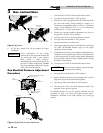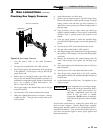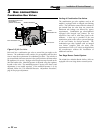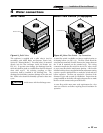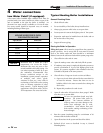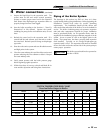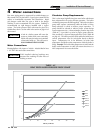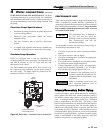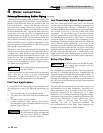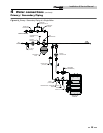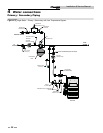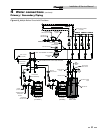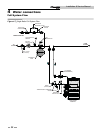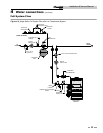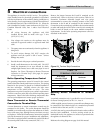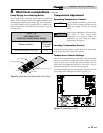
Full Flow Application
It is acceptable for the Solution boiler to be installed in a full
flow application, as long as the following requirements are
met:
1. The performance loop is in place and functional.
2. The system flow is not lower than the minimum boiler
flow.
3. The boiler setpoint is 140°F or higher.
4. If water temperature is below 140°F you must install a
low temperature bypass, VAL30000, and follow the piping
diagram shown in FIG. 4-8.
Boiler Flow Rates
ƽ CAUTION
The maximum flow rate through the boil er
with a copper heat exchanger must not
ex ceed 30 GPM.
The heat exchanger is generally capable of op er at ing within the
flow rates of a residential heating system. Should the flow rate
exceed the maximum allowable flow rate through the boiler 30
GPM) an external bypass must be installed. The bypass should be
fully sized with a balancing valve to al low for proper ad just ment of
flow. Flow rate can be determined by measuring the temperature
rise through the boiler.
The basic guide for minimum flow in this boiler is based on a
40°F temperature rise in most in stal la tions. Low er flow and a
higher temperature rise is acceptable if the boiler system is
specifically de signed for the char ac ter is tics of a higher
tem per a ture rise. A system not specifically designed for a higher
temperature rise may experience over heat ing of the boiler water.
This can cause short burn er on cycles, system noise and in
ex treme cases, a knocking flash to steam. These
con di tions can lead to operational problems and
non-war rant able fail ures of the boiler. High temperature rise
systems must be designed by a qualified engineer.
Low Temperature Bypass Requirements
Inlet water temperatures below 140°F (60°C) can excessively
cool the prod ucts of combustion re sult ing in condensation on
the heat exchanger and in the flue. Condensation can cause
operational prob lems, bad combustion, sooting, flue gas spillage
and reduced service life of the vent system and related
components. The bypass allows part of the boiler discharge
water to be mixed with the cooler boiler return water to in crease
the boiler inlet temperature above 140°F (60°C). This should
prevent the prod ucts of com bus tion from condensing in most
in stal la tions. The bypass should be fully sized with a bal anc ing
valve to allow for proper adjustment. A valve must also be
provided on the boiler discharge, after the by pass. Closing this
discharge valve forces water through the bypass. Start boiler
adjustment with the bypass valve in the full open position and
the boiler discharge valve half open. A small amount of the
high er temperature boiler discharge water is mixed with the
system water to maintain the de sired lower system tem per a ture.
ƽ WARNING
Varying the flow through a Solution boiler
can cause harmonic noises and high limit
trips if the flow is below the minimum
boiler flow rate found in Table 4A.
4 Water connections
28
Installation & Service Manual
ƽ CAUTION
At no time should the system pressure be
less than 12 PSIG.
A boiler operated with an inlet temperature of less than 140°F
(60°C) must have a bypass to prevent problems with
condensation. A bypass as shown in FIG. 4-5 (see page 33)
must be piped into the system at the time of installation.
A primary/secondary piping system is ideal for sys tems filled
with a propylene glycol and water mix ture. A glycol and water
mixture is more dense than water only and may result in a
lower boiler flow rate. A lower boiler flow may cause noisy
operation or short cycling of the burners. A larger secondary
pump may be used on a primary/sec ond ary system to pro vide
an increased boiler flow rate. A glycol and water system may
require from 10 to 20% more flow to compensate for the
in creased density of the glycol and its effect on the heat
transfer process in the boiler. The exact in crease in flow that
may be required is based on the type and percentage of glycol
added to the boiler system. Consult the manufacturer of the
glycol for additional recommendations when using a gly col
and water fill for your boiler system.
The installer must ensure that the boiler has ad e quate flow
without excessive temperature rise. The tem per a ture rise on
a multiple zone system should be made when only the zone
with the longest length and/or high est head loss is open. Low
system flow can result in overheating of the boiler water
which can cause short burner on cycles, system noise and in
extreme cases, a knocking flash to steam. System noise may
also indicate an oversized boiler.
Primary/Secondary Boiler Piping
(continued)



